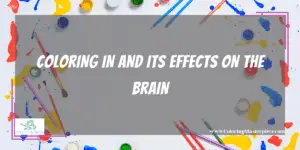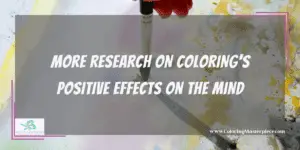Coloring is more than just a relaxing hobby. The effects on the brain are beneficial, helping with relaxation, concentration, and overall mental acuity. Because it uses both sides of the brain, it improves recall and spurs original thought. As a form of therapy, it helps people feel calmer, express themselves more fully, and unwind. Cognitive rehabilitation is provided for stroke patients. Group dynamics are improved as a result. For therapeutic and reflective purposes, art is used in art therapy. As a bonus, coloring has been shown to slow the onset of dementia, increase creativity, and foster an attitude of acceptance. Participate in the restorative power of coloring for better mental health.
Introduction
Coloring books have always been popular with kids, but adults have discovered their therapeutic benefits in recent years. Coloring books and other coloring activities have been shown to provide cognitive benefits beyond their apparent aesthetic value. In this post, we will describe how the seemingly harmless pastime of coloring can increase mental well-being, enhance creativity, and stimulate cognitive development based on research.
To learn about the therapeutic magic of anti-stress coloring books, check out this article.
Coloring in and Its Effects on the Brain

1. Reducing Stress with Mindfulness
Coloring is a great way to relax and meditate since it requires the mind to concentrate on a single, repetitive job. By taking one’s mind off their worries and stressors, relaxation and stress relief are enhanced in this meditative state. Dopamine, a neurotransmitter linked to pleasure and calmness, is released in response to the act of coloring, which stimulates the brain’s reward centers. Therefore, coloring can be a straightforward yet powerful mindfulness practice method linked to numerous positive outcomes for psychological well-being.
2. Improvements in Focus and Awareness
Concentration and focus are required for the intricate process of coloring, which includes selecting colors, filling in empty spaces, and ensuring visual cohesion from beginning to end. Consistently doing this has been shown to boost brain power and cognition. Coloring can be a helpful and relaxing way for people with ADD and other attention issues to practice focused attention and motor control.
3. Learning to Control Your Finer Muscles
Coloring requires careful, controlled motions to fill in detailed drawings. Children, in particular, can benefit from practicing fine motor skills by regularly manipulating coloring tools. Coloring is a great way to develop hand-eye coordination and agility, valuable skills in many areas of life.
4. Combining Left and Right Brain Functions
Coloring encourages well-rounded mental health by using both the left and right sides of the brain at once. Color selection and remaining inside lines engage the left hemisphere’s rationality, whereas color schemes and lateral thinking engage the right hemisphere’s imagination. An increase in problem-solving and imaginative capacities may result from this equilibrium of activation in the brain.
Coloring’s Healing Properties
1. Reducing Anxiety and Stress
Numerous studies have demonstrated that coloring can reduce stress and anxiety by relaxing the brain. Coloring is associated with a rise in the feel-good hormone endorphin, which can help people relax after a stressful day or when facing difficult circumstances. Furthermore, similar to the effects of meditation, the repeated nature of coloring can induce a state of calm and relaxation.
2. Methods of Dealing with Emotional Stress
Individuals experiencing mental health issues, such as depression, PTSD, or anxiety disorders, may find therapeutic value in coloring as a form of creative expression and coping. Coloring is a great way to take your mind off whatever bothers you and return it to the here and now. In addition, persons with mental health concerns can benefit from the boost to self-esteem and sense of success that coloring can provide.
3. Exploration of Emotions and Identity
Coloring is a kind of nonverbal communication that can help people express their feelings, thoughts, and experiences on a deeper level than words alone can. Inadvertently revealing one’s emotional state or personality characteristics through one’s choice of colors or patterns can lead to self-discovery and heightened self-awareness. Art therapy, in which coloring is utilized to explore emotions and foster healing, might benefit significantly from this approach.
4. Facilitating Restful Sleep
Adults and children alike might benefit from engaging in a relaxing hobby like coloring before bed. Coloring has been shown to improve sleep quality by reducing anxious thoughts and promoting relaxation. Due to the correlation between screen time and sleep disruptions, this could be an excellent alternative to watching TV or using a computer right before bed.
Effects of Coloring on Brain Activity
1. Improved Recall
Coloring requires decision-making and the ability to make associations between visual elements. Memory retention and retrieval can be improved by this approach, especially when specific patterns or color combinations are revisited. Coloring in complicated patterns may also help you remember and duplicate complex sequences, which could lead to enhanced memory.
2. Ability to Think Outside the Box and Solve Problems
People exercise their imaginations and build problem-solving skills as they try new color combinations and design patterns. Selecting and applying colors calls for a degree of deliberation and strategic planning that can inspire originality and invention.
More Research on Coloring’s Positive Effects on the Mind

1. Psychological Care for the Mind
Individuals with neurological or brain problems have benefited from coloring as a form of cognitive rehabilitation. Coloring can help with brain retraining by strengthening hand-eye coordination, sharpening focus, and expanding creative problem-solving abilities. The therapeutic repetition of coloring can aid in recovering motor abilities after a stroke.
2. Enhancement of Mood and Modulation of Emotions
Positive effects on mood and emotional regulation can be attributed to coloring. Coloring may be a relaxing and soothing activity that makes you feel good about yourself. People who struggle to maintain dynamic control often find that channeling their energies into creative pursuits helps. People with modest mood disorders or everyday stresses may benefit significantly from this emotional release method through coloring.
3. Communication and Relationship Building
Coloring may also be a fun group activity that opens communication and friendships. In-person or online, coloring groups allow participants to connect with others while sharing their work, discussing ideas, and having fun. This shared experience can help people feel less alone and more connected.
4. Healing through the Arts
Coloring books and other forms of art therapy have been widely acknowledged as helpful in treating emotional and mental health issues. When facilitated by a skilled art therapist, coloring can be a means of introspection, catharsis, and development. Art’s nonverbal character facilitates communication of feelings and experiences that may be difficult to articulate in other ways.
5. Postponing Mental Decay
Coloring is one activity that has been shown to stimulate the brain and may help prevent cognitive decline and lower the risk of neurodegenerative disorders like Alzheimer’s. The decline in mental function accompanying aging can be slowed by engaging in mentally stimulating activities, such as the arts.
6. Increasing Imagination and Creativity
Coloring provides an opportunity for individual expression that doesn’t require strict adherence to the lines. People can freely experiment with new color palettes and artistic approaches when they color. This kind of creative independence is excellent for developing the parts of the brain responsible for problem-solving and original thought since it encourages a sense of play and curiosity.
7. Reducing Worry About Making Mistakes and Self-Criticism
Coloring can be a place to let go of judgment in a world where perfectionism and self-criticism are frequent. Coloring may be done by everyone, regardless of their artistic aptitude, unlike more traditional art forms. Coloring can be a cathartic activity that fosters a more accepting and less critical outlook on oneself and the world.
8. The Constant Pursuit of Knowledge and Improvement
Coloring is a fun and relaxing activity for people of all ages. By gradually increasing the complexity of their patterns, artists challenge themselves and their brains to grow and adapt. Coloring’s everlasting learning potential keeps minds agile and ready for change.
To learn about the stress relief coloring pages, check out this article.
Summary
There is strong empirical evidence that coloring has beneficial effects on the brain. Coloring offers therapeutic benefits for people of all ages, including stress reduction, emotional management, cognitive rehabilitation, and expressive outlets. More studies are anticipated to illuminate the enormous impact that this seemingly simple pastime may have on mental well-being and cognitive function as the popularity of adult coloring books and art therapy continues to rise.
The coloring goes beyond simply making pretty pictures, so keep that in mind when you pick up a coloring book for relaxation or treatment. It’s a chance to learn about yourself and grow emotionally, all while boosting your brain. So dive into a rainbow of happiness, peace, and self-improvement by opening yourself to coloring in a coloring book.
The information provided by ColoringMasterpiece.com (“The Site”) is for general informational purposes only. All information on the Site is provided in good faith, however, we make no representation or warranty of any kind, express or implied, regarding the accuracy, adequacy, validity, reliability, availability, or completeness of any information on the Site. Under no circumstance shall we have any liability to you for any loss or damage incurred due to the use of the Site or Reliance on any information provided on the Site. Your use of the Site and reliance on any information on the Site is solely at your own risk. This blog post is for educational purposes and does not constitute legal advice. Please consult a legal expert to address your specific needs.
